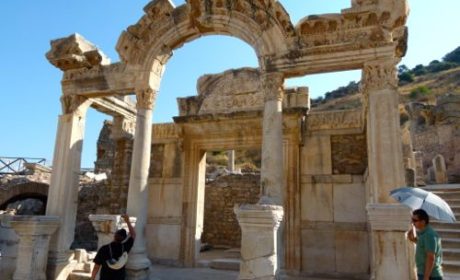
The Library of Celsus is probably the most photographed ruin in Ephesus, Turkey. Constructed between 110 and 135 A.D. by Julius Aquilla in memory of his father, Celsus Polemaeanus, a Roman Senator and Governor of Asia, the elegant building was more than just a library. It was also Celsus Polemaeanus’ tomb, which was located in a sarcophagus beneath the main floor according to Wikipedia.
Archaeologist’s believe that 12,000 scrolls were housed in cupboards built into niches on the wall. A single hall faced East to take advantage of the morning sun. And the library was richly decorated in colored marble, carvings and decorations.
What you see today is a reconstruction. Austrian archaeologist, F. Hueber of the Austrian Archaeological Institute, supervised the rebuilding of the facade between 1970 and 1978. And the statues in the niches on the lower level are copies of the originals, which now live in Vienna.
Why was it necessary to rebuild the Library of Celsius? Through the years, the building experienced tough times. In 202 A.D., the Goths invaded Ephesus, burning the library and scrolls. Later, earthquakes completed the devastation.
I visited the Library of Celsus on a Royal Princess cruise excursion to Ephesus. Arriving at the back gate, we walked through the upper portions of the archeological site before strolling downhill on Curetes Way, where the imposing Library of Celsus waited to be explored at the bottom of the hill.
Are you planning a cruise? Use our Luxury Cruise Travel Planning Guide to begin your research.
If your visit to Ephesus begins at the south gate, I recommend that you hurry past the library and turn left on Curetes Way. Walk uphill, then, turn around to view the Library of Celsus for a memorable first look.
Your tour guide will probably tell you that a tunnel existed from the Libary of Clesus across the way to a drinking establishment or brothel. The Roman men would tell their wives they were going to the library to read but take the tunnel to their real goal—decadent fun. Is it a true story? In researching this article, I could only find mention of the tale on a Turkish guiding site, so you be the judge.



